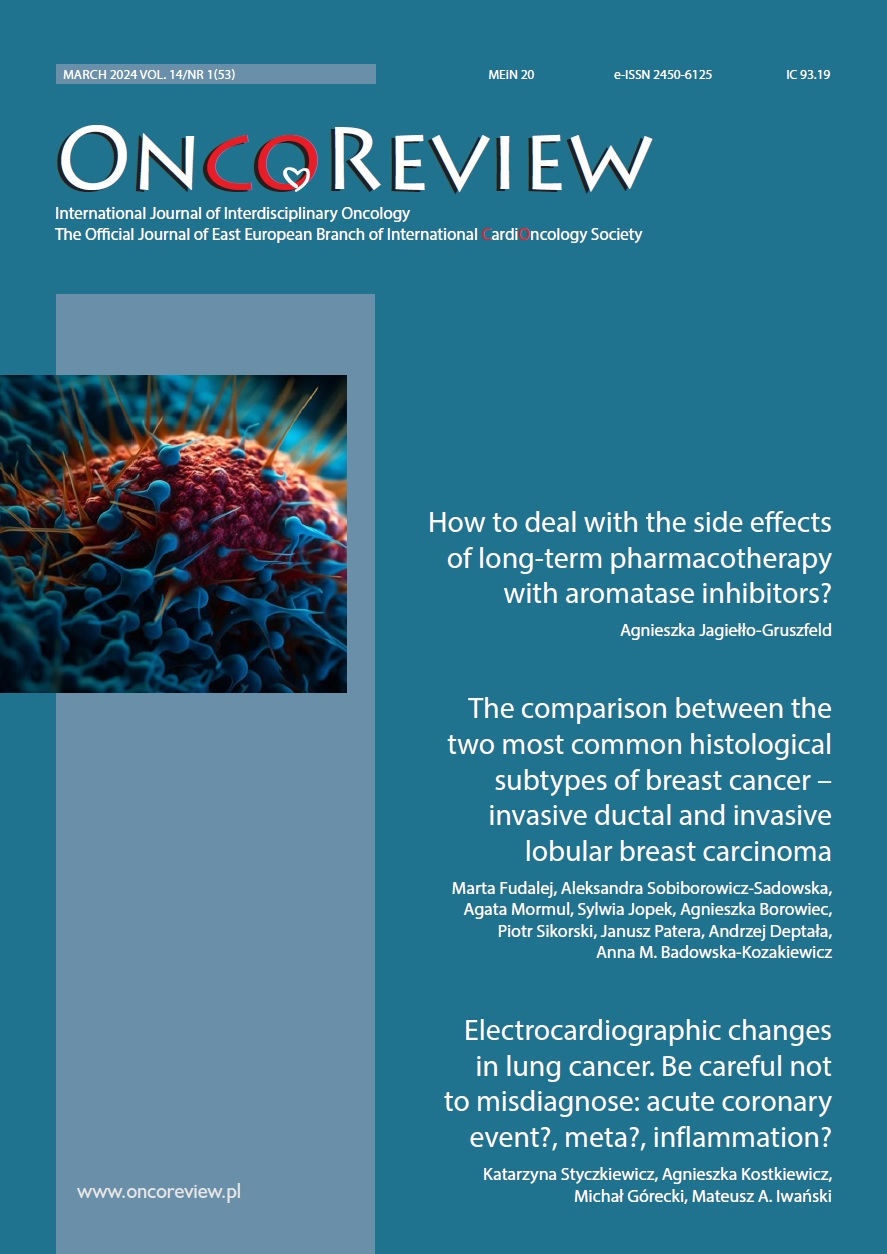Electrocardiographic changes in lung cancer. Be careful not to misdiagnose: acute coronary event? meta? inflammation? Case report
Main Article Content
Abstract
In cancer patients changes in the electrocardiogram (ECG) may indicate various causes. The presented case concerns a patient with advanced left lung cancer who presented deep inversion of T waves during ongoing chemotherapy. We excluded acute coronary syndrome, acute pulmonary embolism, and myocarditis. Subsequently, we suspected metastases to the myocardium; therefore, we performed cardiac magnetic resonance imaging, which however did not confirm that. The cardiac magnetic resonance imaging showed residual post-inflammatory changes in the left lung. We publish this case to show that the inflammatory process of lung segments adjacent to the heart may cause temporal myocardial oedema, resulting in ECG changes that may mimic acute coronary events.
Downloads
Metrics
Article Details

This work is licensed under a Creative Commons Attribution-NonCommercial 4.0 International License.
Copyright: © Medical Education sp. z o.o. This is an Open Access article distributed under the terms of the Attribution-NonCommercial 4.0 International (CC BY-NC 4.0). License (https://creativecommons.org/licenses/by-nc/4.0/), allowing third parties to copy and redistribute the material in any medium or format and to remix, transform, and build upon the material, provided the original work is properly cited and states its license.
Address reprint requests to: Medical Education, Marcin Kuźma (marcin.kuzma@mededu.pl)
References
2. Fradley MG, Beckie TM, Brown SA et al. Recognition, Prevention, and Management of Arrhythmias and Autonomic Disorders in Cardio-Oncology: A Scientific Statement From the American Heart Association. Circulation. 2021; 144: 41-55. http://doi.org/10.1161/CIR.0000000000000986.
3. Yun JP, Choi EK, Han KD et al. Risk of Atrial Fibrillation According to Cancer Type: A Nationwide Population-Based Study. JACC CardioOncol. 2021; 3: 221-32. http://doi.org/10.1016/j.jaccao.2021.03.006.
4. Kumar M, Lopetegui-Lia N, Malouf CA et al. Atrial fibrillation in older adults with cancer. J Geriatr Cardiol. 2022; 19: 1-8. http://doi.org/10.11909/j.issn.1671-5411.2022.01.001.
5. Enriquez A, Biagi J, Redfearn D et al. Increased Incidence of Ventricular Arrhythmias in Patients With Advanced Cancer and Implantable Cardioverter- Defibrillators. JACC Clin Electro-physiol. 2017; 3: 50-56. http://doi.org/10.1016/j.jacep.2016.03.001.
6. Costa IBSDS, Andrade FTA, Carter D et al. Challenges and Management of Acute Coronary Syndrome in Cancer Patients. Front Cardiovasc Med. 2021; 8: 590016. http://doi.org/10.3389/fcvm.2021.590016.
7. Bharadwaj A, Potts J, Mohamed MO et al. Acute myocardial infarction treatments and outcomes in 6.5 million patients with a current or historical diagnosis of cancer in the USA. Eur Heart J. 2020; 41: 2183-2193. http://doi.org/10.1093/eurheartj/ehz851.
8. Collet JP, Thiele H, Barbato E et al. 2020 ESC Guidelines for the management of acute coronary syndromes in patients presenting without persistent ST-segment elevation. Eur Heart J. 2021; 42: 1289-1367. http://doi.org/10.1093/eurheartj/ehaa575.
9. Yusuf SW, Daraban N, Abbasi N et al. Treatment and outcomes of acute coronary syndrome in the cancer population. Clin Cardiol. 2012; 35: 443-50. http://doi.org/10.1002/clc.22007.
10. Ozaki T, Chiba S, Annen K et al. Acute coronary syndrome due to coronary artery compression by a metastatic cardiac tumor. J Cardiol Cases. 2009; 1: 52-5. http://doi.org/10.1016/j.jccase.2009.07.005.
11. Pan KL, Wu LS, Chung CM et al. Misdiagnosis: cardiac metastasis presented as a pseudo-infarction on electrocardiography. Int Heart J. 2007; 48: 399-405. http://doi.org/10.1536/ihj.48.399.
12. Yao NS, Hsu YM, Liu JM et al. Lung cancer mimicking acute myocardial infarction on electrocardiogram. Am J Emerg Med. 1999; 17: 86-8. http://doi.org/10.1016/s0735-6757(99)90026-8.
13. Vallot F, Berghmans T, Delhaye F et al. Electrocardiographic manifestations of heart metastasis from a primary lung cancer. Support Care Cancer. 2001; 9: 275-7. http://doi.org/10.1007/s005200000212.
14. Juan O, Esteban E, Sotillo J et al. Atrial flutter and myocardial infarction-like ECG changes as manifestations of left ventricle involvement from lung carcinoma. Clin Transl Oncol. 2008; 10: 125-7. .
15. Samaras P, Stenner-Liewen F, Bauer S et al. Images in cardiovascular medicine. Infarction-like electrocardiographic changes due to a myocardial metastasis from a primary lung cancer. Circulation. 2007; 115: 320-1. http://doi.org/10.1161/CIRCULATIONAHA.106.650762.
16. Lim HE, Pak HN, Jung HC et al. Electrocardiographic manifestations of cardiac metastasis in lung cancer. Pacing Clin Electrophysiol. 2006; 29: 1019-21. http://doi.org/10.1111/j.1540-8159.2006.00480.x.
17. Said SA, Bloo R, de Nooijer R et al. Cardiac and non-cardiac causes of T-wave inversion in the precordial leads in adult subjects: A Dutch case series and review of the literature. World J Cardiol. 2015; 7: 86-100. http://doi.org/10.4330/wjc.v7.i2.86.
18. Lestuzzi C, Nicolosi GL, Biasi S et al. Sensitivity and specificity of electrocardiographic ST-T changes as markers of neoplastic myocardial infiltration. Echocardiographic correlation. Chest. 1989; 95: 980-5. http://doi.org/10.1378/chest.95.5.980.
19. Liu J, Banchs J, Mousavi N et al. Contemporary Role of Echocardiography for Clinical Decision Making in Patients During and After Cancer Therapy. JACC Cardiovasc Imaging. 2018; 11: 1122-31. http://doi.org/10.1016/j.jcmg.2018.03.025.
20. Baldassarre LA, Ganatra S, Lopez-Mattei J et al. Advances in Multimodality Imaging in Cardio-Oncology: JACC State-of-the-Art Review. J Am Coll Cardiol. 2022; 80: 1560-78. http://doi.org/10.1016/j.jacc.2022.08.743.
21. Kukla P, Długopolski R, Krupa E et al. How often pulmonary embolism mimics acute coronary syndrome? Kardiol Pol. 2011; 69: 235-40.
22. Migliore F, Zorzi A, Marra MP et al. Myocardial edema underlies dynamic T-wave inversion (Wellens' ECG pattern) in patients with reversible left ventricular dysfunction. Heart Rhythm. 2011; 8: 1629-34. http://doi.org/10.1016/j.hrthm.2011.04.035.
23. Kunishige R, Matsuoka Y, Yoshimura R et al. Cardiac metastasis of lung cancer presented as mimicking ST-elevation myocardial infarction with reciprocal electrocardiographic changes. J Cardiol Cases. 2022; 26: 173-7. http://doi.org/10.1016/j.jccase.2022.04.004.
24. Kim YM, Nam HS, Kim CH et al. ST segment elevation and T wave inversion on electrocardiograms 2 years after surgery for lung cancer. J Thorac Oncol. 2008; 3: 1363-4. http://doi.org/10.1097/JTO.0b013e318189f591.
25. Shenoy C, Grizzard JD, Shah DJ et al. Cardiovascular magnetic resonance imaging in suspected cardiac tumour: a multicentre outcomes study. Eur Heart J. 2021; 43: 71-80. http://doi.org/10.1093/eurheartj/ehab635.
26. Liang X, Geng X, Gong X et al. Wellens syndrome during chemotherapy for cholangiocarcinoma: A case report of cardiovascular toxicity associated with gemcitabine-containing regimen. Medicine (Baltimore). 2023; 102: 33599. http://doi.org/10.1097/MD.0000000000033599.

